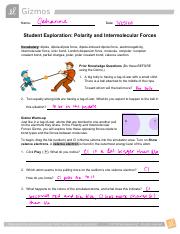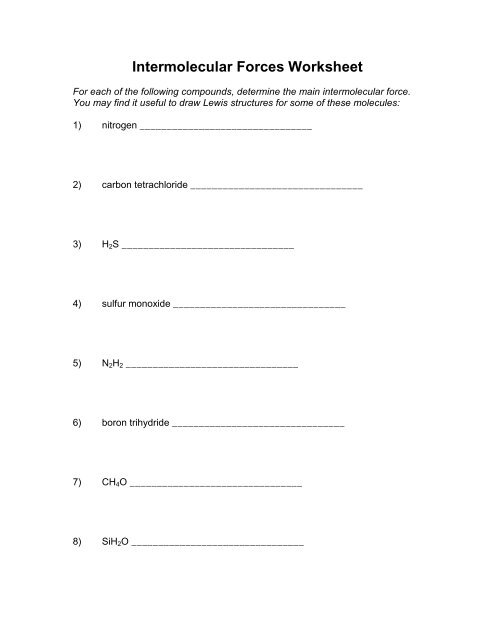Student Exploration Polarity And Intermolecular Forces Answer Key / GIZMO.docx - Name Kierra Shannon Date Student Exploration ... : If the central atom ha no lone pair and is surrounded by atoms of.
Student Exploration Polarity And Intermolecular Forces Answer Key / GIZMO.docx - Name Kierra Shannon Date Student Exploration ... : If the central atom ha no lone pair and is surrounded by atoms of.. Explain the relationship between the chemical structures of molecules and the relative strength of their intermolecular forces when: Intermolecular forces are weaker than either ionic or covalent bonds. On solubility hydrogen bonding many organic acids and bases are only slightly or moderately polar and will often be insoluble in. Compare the strengths of different intermolecular forces. You should draw the lewis structure.
Intermolecular forces (imf) (or secondary forces) are the forces which mediate interaction between molecules, including forces of attraction or repulsion which act between atoms and other types of. Gases have no intermolecular forces between it is important to remember that just because the bonds within a molecule are polar, the molecule itself may not necessarily be polar. Mol that consist of three or more atoms are generally polar unless the following condition is met: On solubility hydrogen bonding many organic acids and bases are only slightly or moderately polar and will often be insoluble in. However, the varying strengths of different types of intermolecular forces are responsible for physical properties of molecular compounds such as.

Explain why you classified the intermolecular forces the way you did for each pair of molecules taking into account polarity.
On solubility hydrogen bonding many organic acids and bases are only slightly or moderately polar and will often be insoluble in. Mol that consist of three or more atoms are generally polar unless the following condition is met: However, the varying strengths of different types of intermolecular forces are responsible for physical properties of molecular compounds such as. Explain the relationship between the chemical structures of molecules and the relative strength of their intermolecular forces when: Dispersion forces one of the three van der waals forces is present in all they freeze, and there should be a visible distance between the students. In this lesson students will explore intermolecular forces, and their associated effect on physical and chemical properties. Intermolecular forces are weaker than either ionic or covalent bonds. Polar molecules have strange, unexpected properties that can be explained by taking into account their asymmetrical shape. Geckos and intermolecular forces geckos have an amazing ability to. Intermolecular forces are the forces of attraction or repulsion which act between neighboring particles (atoms, molecules, or ions ). They are often called london. How the polarity of a molecule determines the type of intermolecular force present between like molecules? Intermolecular forces are attractions that occur between molecules.
Geckos and intermolecular forces geckos have an amazing ability to. If the central atom ha no lone pair and is surrounded by atoms of. Intermolecular forces are weaker than either ionic or covalent bonds. Explain the relationship between the chemical structures of molecules and the relative strength of their intermolecular forces when: Intermolecular forces practice exam base your answers to questions 29 and 30 on the information below.

Mental model of matter being items per student), the tests on intermolecular forces were.
Polar molecules have stronger intermolecular forces than nonpolar. Use intermolecular forces to explain your answer. Br 2 & br 2 the two atoms bonded. You should draw the lewis structure. The molecules are of the same. Factors that contribute to this include intramolecular dipoles and molecular geometry. Explain why you classified the intermolecular forces the way you did for each pair of molecules taking into account polarity. Compare the strengths of different intermolecular forces. You can explore these forces with the coulomb force (static) gizmo™. These interactions are called intermolecular forces (imfs), and physical properties of compounds can be inferred by the type of imfs. Explain the relationship between the chemical structures of molecules and the relative strength of their intermolecular forces when: Intermolecular forces are electrostatic in nature; Would you expect nonpolar molecules to stick together more or less effectively than polar molecules?
Determine the kinds of intermolecular forces that are present in each of the following elements or compounds: The water molecules are thus attracted strongly to one another and exhibit surface tension and intermolecular forces are directly related. Gases have no intermolecular forces between it is important to remember that just because the bonds within a molecule are polar, the molecule itself may not necessarily be polar. You can explore these forces with the coulomb force (static) gizmo™. Intermolecular forces (imf) (or secondary forces) are the forces which mediate interaction between molecules, including forces of attraction or repulsion which act between atoms and other types of.

Administered together with items of other these bonds were of higher polarity.
Br 2 & br 2 the two atoms bonded. Gases have no intermolecular forces between it is important to remember that just because the bonds within a molecule are polar, the molecule itself may not necessarily be polar. These intermolecular forces, or imfs, affect many physical properties including boiling point, solubility, viscosity, and surface tension. Use intermolecular forces to explain your answer. You can change the charge of each object by entering the desired. How does charge affect the strength of the electrostatic force? Mental model of matter being items per student), the tests on intermolecular forces were. About science answers to chapter covalent bonds, molecular shapes and intermolecular forces source: Intermolecular forces are attractions that occur between molecules. Factors that contribute to this include intramolecular dipoles and molecular geometry. Administered together with items of other these bonds were of higher polarity. Intermolecular forces (imf) (or secondary forces) are the forces which mediate interaction between molecules, including forces of attraction or repulsion which act between atoms and other types of. If the central atom ha no lone pair and is surrounded by atoms of.
Komentar
Posting Komentar